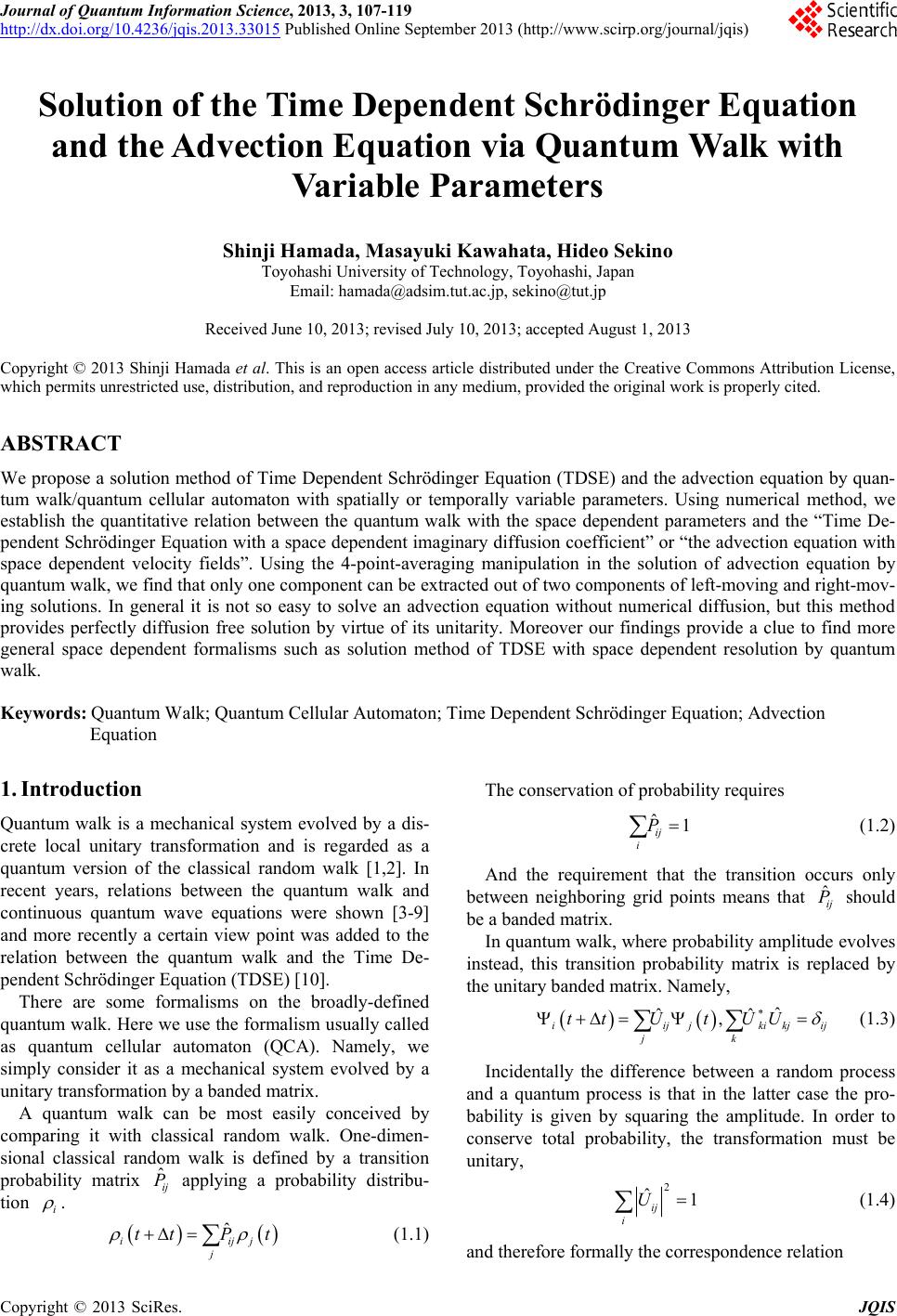 Journal of Quantum Information Science, 2013, 3, 107-119 http://dx.doi.org/10.4236/jqis.2013.33015 Published Online September 2013 (http://www.scirp.org/journal/jqis) Solution of the Time Dependent Schrödinger Equation and the Advection Equation via Quantum Walk with Variable Parameters Shinji Hamada, Masayuki Kawahata, Hideo Sekino Toyohashi University of Technology, Toyohashi, Japan Email: hamada@adsim.tut.ac.jp, sekino@tut.jp Received June 10, 2013; revised July 10, 2013; accepted August 1, 2013 Copyright © 2013 Shinji Hamada et al. This is an open access article distributed under the Creative Commons Attribution License, which permits unrestricted use, distribution, and reproduction in any medium, provided the original work is properly cited. ABSTRACT We propose a solution method of Time Dependent Schrödinger Equation (TDSE) and the advection equation by quan- tum walk/quantum cellular automaton with spatially or temporally variable parameters. Using numerical method, we establish the quantitative relation between the quantum walk with the space dependent parameters and the “Time De- pendent Schrödinger Equation with a space dependent imaginary diffusion coefficient” or “the advection equation with space dependent velocity fields”. Using the 4-point-averaging manipulation in the solution of advection equation by quantum walk, we find that only one component can be extracted out of two components of left-moving and right-mov- ing solutions. In general it is not so easy to solve an advection equation without numerical diffusion, but this method provides perfectly diffusion free solution by virtue of its unitarity. Moreover our findings provide a clue to find more general space dependent formalisms such as solution method of TDSE with space dependent resolution by quantum walk. Keywords: Quantum Walk; Quantum Cellular Automaton; Time Dependent Schrödinger Equation; Advection Equation 1. Introduction Quantum walk is a mechanical system evolved by a dis- crete local unitary transformation and is regarded as a quantum version of the classical random walk [1,2]. In recent years, relations between the quantum walk and continuous quantum wave equations were shown [3-9] and more recently a certain view point was added to the relation between the quantum walk and the Time De- pendent Schrödinger Equation (TDSE) [10]. There are some formalisms on the broadly-defined quantum walk. Here we use the formalism usually called as quantum cellular automaton (QCA). Namely, we simply consider it as a mechanical system evolved by a unitary transformation by a banded matrix. A quantum walk can be most easily conceived by comparing it with classical random walk. One-dimen- sional classical random walk is defined by a transition probability matrix applying a probability distribu- tion ˆij P i . ˆ iij j ttP t j (1.1) The conservation of probability requires ˆ1 ij i P (1.2) And the requirement that between neighboring grid points means that should be e l the transition occurs only ˆij P a banded matrix. In quantum walk, where probability amplitud evolves instead, this transition probability matrix is repaced by the unitary banded matrix. Namely, * , ˆˆ ˆ iijjkikjij jk ttUt UU (1.3) Incidentally the difference between a random and a quantum process is that in the latter case the pro- ba process bility is given by squaring the amplitude. In order to conserve total probability, the transformation must be unitary, 2 ˆ1 ij U (1.4) i and therefore formally the correspondence relation C opyright © 2013 SciRes. JQIS 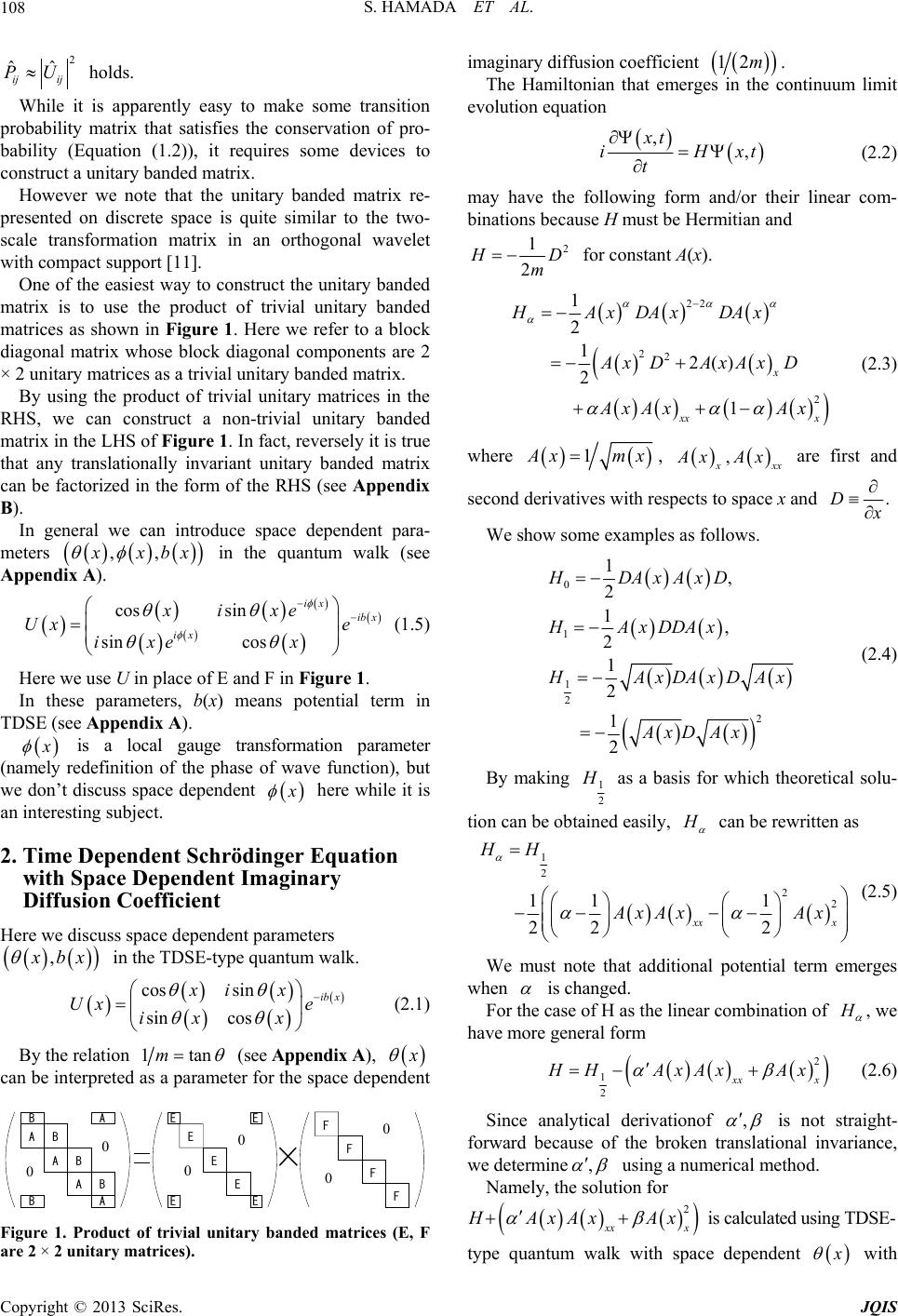 S. HAMADA ET AL. 108 2 ˆˆ ij ij PU holds. While it is apparently easy to make some transition f pro- bability ((1.2)), it requires some devices to con probability matrix that satisfies the conservation o Equation struct a unitary banded matrix. However we note that the unitary banded matrix re- presented on discrete space is quite similar to the two- scale transformation matrix in an orthogonal wavelet with compact support [11]. One of the easiest way to construct the unitary banded matrix is to use the product of trivial unitary banded matrices as shown in Figure 1. Here we refer to a block diagonal matrix whose block diagonal components are 2 × 2 unitary matrices as a trivial unitary banded matrix. By using the product of trivial unitary matrices in the RHS, we can construct a non-trivial unitary banded matrix in the LHS of Figure 1. In fact, reversely it is true that any translationally invariant unitary banded matrix can be factorized in the form of the RHS (see Appendix B). In general we can introduce space dependent para- meters ,, xbx in the quantum walk (see Appendix A). cos sin si cos ix ib x xi xe Ux e ix x (1.5) nix e Here we use U in place of E and F in Figure 1. In these parameters, b(x) means potential te TDSE (see Appendix A). rm in is a local gauge transformation pa amely redefinition of the phase of wave functio rameter (nn), but we don’t discuss space dependent here while it is an interesting subject. 2. Time Dependent Schrödinger Equation with Space Dependent Imaginary Diffusion Coefficient Here we discuss space dependent parameters , bx in the TDSE-type quantum walk. cos xi sin cosix x tion sin ib x x Ux e (2.1) By the rela1tanm (see Appendix A), can be interpreted as a parameter for the space dependent A B A B A B A B A B E E E EF F F F E E E 0 0 0 0 0 0 0 0 0 0 0 0 Figure 1. Product of trivial unitary banded matrices (E, F are 2 × 2 unitary matrices). imaginary diffusion coefficient 12m. erges in the cThe Hamiltonian that emontinuum limit evolution equation ,, xt iHxt (2.2 and/or their linear com- rmitian an t may have the following form ) binations because H must be Hed 2 1 2 D m for constant A(x). 222( 1 2)x 22 2 1 2 1 x AxAx x HA xDAxDAx A AxAx DAxD where (2.3) 1 xmx , , xx Ax Ax pects to space x are first and second derivatives with res and .D We show some examples as follows. 0 2 1, 2 1, 1 2 H DAxAxD HAxDDAx 12 1 1 22 AxDAxD A x AxDAx (2.4 By making ) 1 2 as a basis for which theoretical solu- tion can be obtained easily, can be rewritten as 1 2 2 2 11 1 HH 22 2 xx xAxAx (2.5) onages We must note that additil potential term emer when is changed. For the case of H as the linear combination of , we have more general form 2 1 2 xx HAxAxAx (2.6) Since analytical derivationof , is not straight- forwarbecause of the d broken traslational invariance, w n e determine, using a numerical method. Namely, the solution for 2 xx AxAx Ax is calculated usin type quantum walk with space dependent g TDSE- with Copyright © 2013 SciRes. JQIS  S. HAMADA ET AL. 109 additional potential term 2 xx x Ax and compared with the analytical solution for Ax 1 2 . We determine, so that the two solutions com- pletely coincide. The used 2 × 2 matrix of quantum walk is cos s sin cos xi Ux e ix x (2.7) in ib x x wheretan, 2 ' 2 xx xAx x bx AxAx Ax (Note that for the space dependent , phase com- pensation term , the first term in bx is crucial and leads to mss results without it). In our numerical method, we use periodic boundary condition for the range [0,1], and use two types of A(x). (More precisely, in the actual calculation the range [0,1] was mapped to the range [0,512]) 1) sine function type eaningle 0 0 0.5,5 1sin2π A Ax A x (2.8) 0. 2) elliptic function type 0.5,0A 2 0.9k (2.9) where 4K(k) is the period along the real axis of elliptic function s 0 2π 44, A Ax Kk dnKkx k Jacobi’s Both type of A(x) satisfie 1 0 0 d1x xA (2.10) In order to calculate the theoretical solution for 1 2 , 2 2 1 , , tx iH tx t xD Axtx (2.11) we can simply reduce it to the solution of the free fields TD SE 0,tx . 02 0 ,1, 2 tx iD t tx (2.12) 2 00 0 0 wh ,? edre xA (2.13) 11Bx Bx , tAB x tx Ax Bx x Ax (Note that as , the periodicity ,tx is guaranteed). nction forms for the B( ,1tx Concrete fux) are cos 2π1, 2π 1arg 4,4, 2π Bx xx Bxcn Kkxkisn Kkxk (2.14) for sine function type and elliptic function type respec- tiv We use the fact olution of the free fien be written [12] as ely. that theoretical s ld TDSE for the Gaussian wave packet ca 2 00 ,exp 0 11 Ct txCt x B C (2.15) an condition. Here C, B are complex numbers and B is constant in general (Note that as C, B are complex n wave packet center of where 2 0it CtC d we use periodic superposition of this 0 ψ,,txtx n for the periodic boundary 00 n umbers, the 2 ,tx is not B but changes with time). for the We show the result of th ures 2-5. We used 00,exp 100.tx x initial wave packet. 2 5 e numerical solution in Fig- Figure 2. Parameter fitting for sine function type A(x) (after 50000 walks) dash-dotted red: theoretical solution, dotted green: (α′, β) = (0, −0.125), solid blue: (α′, β) = (−0.25, −0.125), dashed magenta: (α′, β) = (−0.5, −0.125). Here, β = −0.125 is fixed and α′ is varied. At α′ = −0.25, the quantum walk solution coincides with the theoretical solution. 512 grid points are used. Absolute values of two-point-averaged ψ are plotted. ,,, ave2 ψ12 ψψΔtxtxtx x. Copyright © 2013 SciRes. JQIS 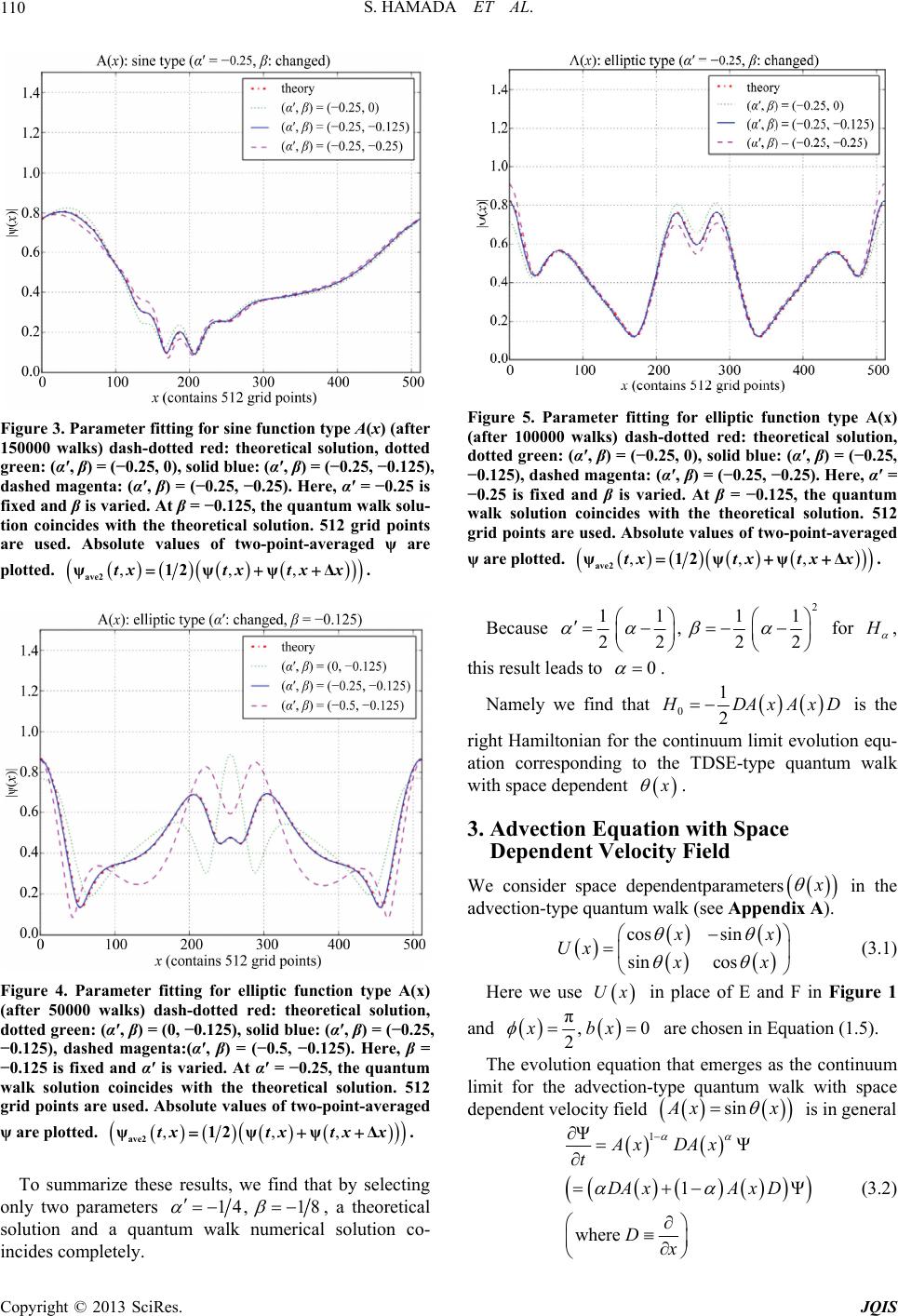 S. HAMADA ET AL. 110 Figure 3. Parameter fitting for sine function type A(x) (after 150000 walks) dash-dotted red: theoretical solution, dotted green: (α′, β) = (−0.25, 0), solid blue: (α′, β) = (−0.25, −0.125), dashed magenta: (α′, β) = (−0.25, −0.25). Here, α′ = −0.25 is fixed and β is varied. At β = −0.125, the quantum walk solu- tion coincides withints the theoretical solution. 512 grid po are used. Absolute values of two-point-averaged ψ are plotted. ,,, ave2 ψ12 ψψΔtxtxtx x. Figure 4. Parameter fitting for elliptic function type A(x) (after 50000 walks) dash-dotted red: theoretical solution, dotted green: (α′, β) = (0, −0.125), solid blue: (α′, β) = (−0.25, −0.125), d −0.125 is ashed magenta:(α′, β) = (−0.5, −0.125). Here, β = fixed and α′ is varied. At α′ = −0.25, the quantum alk solution coincides with the theoretical solution. 512 points are used. Absolute values of two-point-averaged ψ are plotted. w grid ,,, ave2 ψ12 ψψΔtxtxtx x. To summarize these results, we find that by selecting only two parameters 14, 18 , tum walk num Figure 5. Parameter fitting for elliptic function type A(x (after 100000 walks) dash-dotted red: theoretical solution, dotted green: (α′, β) = (−0.25, 0), solid blue: (α′, β) = (−0.25, −0.125), dashed magenta: (α′, β) = (−0.25, −0.25). Here, α′ = −0.25 is fixed and β is varied. At β = −0.125, the quantum walk solution coincides with the theoretical solution. 512 grid points are used. Absolute values of two-point-averaged ψ are plotted. ) ,,, ave2 ψ12 ψψΔtxtxtx x. Because 2 11 11 , 2 2 for 22 , this result leads to 0 . Namely we find that 0 1 2 DA xA xD is the right Hamiltonian for the continuum limit evolution equ- ation corresponding to the TDSE-type quantum walk with space dependent . 3. Advection Equation with Space Dependent Velocity Field We consider space dependentparameters x A). in the advection-type quantum walk (see Appendi cossin sin cos x Ux x (3.1) Here we use Ux in place of E and F in Figure 1 and π,0 2 xbx are chosen in Equation (1.5). The evolution equation that emerges as the continuum limit for the advection-type quantum walk with space dependent velocity field sin xx is in general 1 ΨΨ 1Ψ Ax DAx t DA xA x D (3.2) a theoretical solution and a quanerical solution co- incides completely. where Dx Copyright © 2013 SciRes. JQIS  S. HAMADA ET AL. 111 Especiall 1 0, 1 2and y correspond to y-type and conserving-type advection ely (Note that there is a relation non-con- serving-type, unitar equations respectiv between unitard con- y-type solution an serving-type solution ). However since quantum walk is a unitary transforma- tion, only the unitary-type advection equation is allowed. In the following, wvee instigate using a numerical ion indeed e periodic boundary follow (More precisely, in the actual calculation the range [0,1] was mapped to the range [0,512]) method if the unitary-type advection equat emerges as a solution for continuum limit. In our numerical method, we us condition for the range [0,1], and use the ing type of A(x). 0 0.50.5Ax A , (3.3) 0 1s in2π A an x d this satisfies 1 0 d1x Ax (3.4) 0 A In order to calculate the theoretical solution for 1 ,, tx xDAx tx t (3.5) we can simply reduce it to the solution of the constant velocity field ( 1Ax x (w ) adve here F ction equation ,txFt(x) is an arbitrary periodic 0 function of which period = 1). 0 0 ,, tx tx t (3.6) 00 ,? ,tAB x tx 0 where d x Ax A Bx x (3.7) 0Ax (Note that as 11Bx Bx , the periodicity tx ,1 ,tx is guaranteed). We used 2 00,exp 10tx x 0.5 for the initial wave packet. In fact, in the case of advection type quantu both left moving and right moving components emerge. that using the 4-point-averaging mani- ract only the one component (see Appendix C). 4-point-averaging is an aver four neighboring grid points in space-time. m walk, However we find pulation, we can ext aging manipulation over Δ ,Δ,Δtt x ttxx Now, if we a 4, ave tx 1,,Δ 4tx txx ssume (3.8) ,,Δtxtx x then 1 Δ,Δcossin 1 ttxx Δ ,sin cos1 cos cos sin ttx sin (3.9) and therefore 2 4 1cos ,c 2 os ave tx 2 . It means that by 4-point-averaging the wave function factor of scales with a 2 cos 2 . In order to sotions by using quan int-averaging, we lve advection equa- tum walk with 4-po must consider this faot straightforward to deduce the ri scripto account the factor in a purely th e examined three different prescrip- tio ctor. It is nght pre- tion to take ineo- retical way. We her ns to account the factor using numerical method. Here we refer to the wave function of quantum walk as ,tx , and refer to the solution of the advection equation to be solved as ,tx . Three methods we use follows (At initial time are as 0t , 0,tx is loaded to 0,tx with/ without scaling factor, and at any time (0)t 4, ave tx is copied to ,tx with/w ithout ng). scaling factor for plotti ,:tx 2 ave4 0, 0, :, cos 2 ψ, tx tx tx (Method 1) ave4 0, 0, :, cos 2 ψ, ,: cos 2 tx tx tx tx (Method 2) ave4 2 cos2 We show the numerical solutions in Figures 6-8 using the above prescriptions. To summarize, from the numerical examination we find that method 2 is the right prescription. 0,:0,,tx tx ψ, ,: tx tx (Method 3) Copyright © 2013 SciRes. JQIS 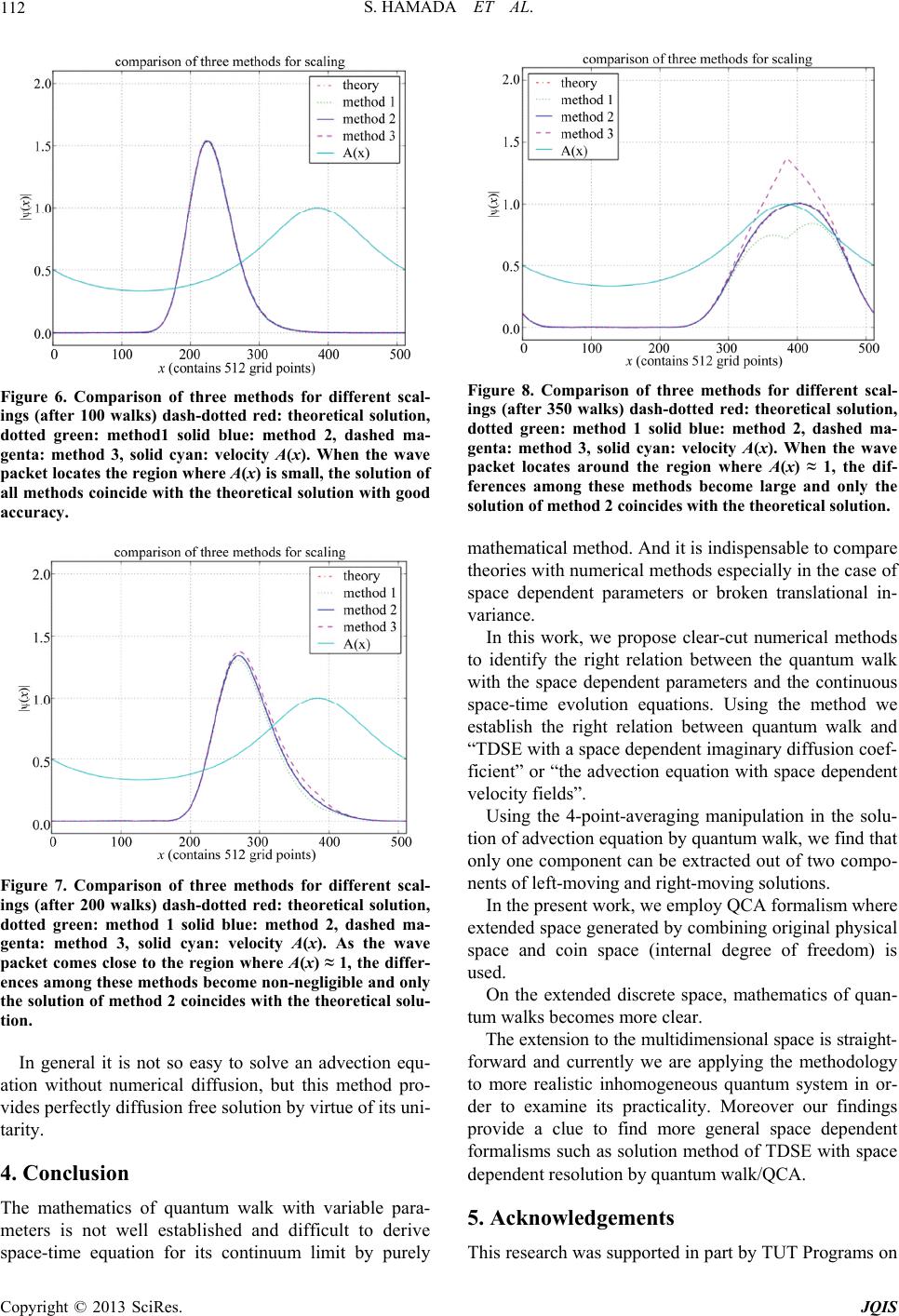 S. HAMADA ET AL. 112 Figure 6. Comparison of three methods for different scal- ings (after 100 walks) dash-dotted red: theoretical solution, dotted green: method1 solid blue: met genta: method 3, solid cyan: velocity A(x). When the wave packet locates the region where A(x) is small, the solution of all methods coincide with the theoretical solution with good accuracy. hod 2, dashed ma- Figure 7. Comparison of three methods for different scal- ings (after 200 walks) dash-dotted red: theoretical solution, dotted green: method 1 solid blue: method 2, dashed ma- genta: method 3, solid cyan: velocity A(x). As the wave packet comes close to the region where A(x) ≈ 1, the differ- ences among these methods become non-negligible and only the solution of method 2 coincides with the theoretical solu- tion. he mathematics of quantum walk with variable para- meters is not well established and difficult to derive space-time equation for its continuum limit by purely In general it is not so easy to solve an advection equ- ation without numerical diffusion, but this method pro- vides perfectly diffusion free solution by virtue of its uni- tarity. 4. Conclusion T Figure 8. Comparison of three methods for different scal- ings (after 350 walks) dash-dotted red: theoretical solution, dotted green: method 1 solid blue: method 2, dashed ma- genta: method 3, solid cyan: velocity A(x). When the wave packet locates around the region where A(x) ≈ 1, the dif- ferences among these methods become large and only the solution of method 2 coincides with the theoretical solution. mathematical method. And it is indispensable to compare th is work, we propose clear-cut numerical methods to identify the right relation between the quantum walk ndent parameters and the continuous velocity fields”. Using the 4-point-averaging manipulation in the solu- tion of advection equation by quantum walk, we find that only one component can be extracted out of two compo- nents of left-moving and right-moving solutions. In the present work, we employ QCA formalism where extended space generated by combining original physical space and coin space (internal degree of freedom) is used. On the extended discrete space, mathematics of quan- tum walks becomes more clear. The extension to the multidimensional space is straight- forward and currently we are applying the methodology to more realistic inhomogeneous quantum system in or- his research was supported in part by TUT Programs on eories with numerical methods especially in the case of space dependent parameters or broken translational in- variance. In th with the space depe space-time evolution equations. Using the method we establish the right relation between quantum walk and “TDSE with a space dependent imaginary diffusion coef- ficient” or “the advection equation with space dependent der to examine its practicality. Moreover our findings provide a clue to find more general space dependent formalisms such as solution method of TDSE with space dependent resolution by quantum walk/QCA. 5. Acknowledgements T Copyright © 2013 SciRes. JQIS 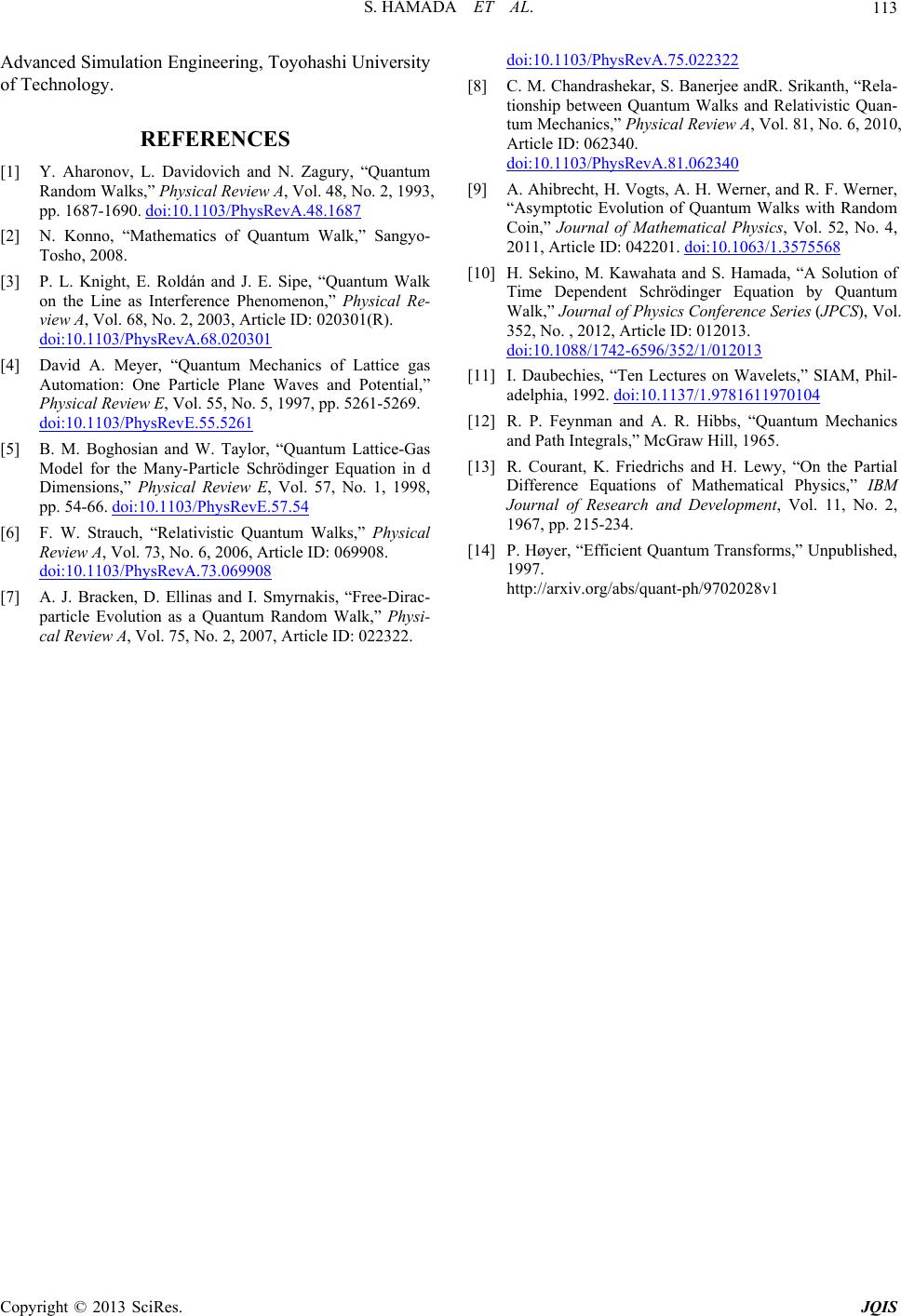 S. HAMADA ET AL. Copyright © 2013 SciRes. JQIS 113 Advanced Simulation Engineering, Toyohashi University of Technology. REFERENCES [1] Y. Aharonov, L. Davidovich and N. Zagury, “Quantum Random Walks,” Physical Review A, Vol. 48, No. 2, 1993, pp. 1687-1690. doi:10.1103/PhysRevA.48.1687 [2] N. Konno, “Mathematics of Quantum Walk,” Sangyo- Tosho, 2008. [3] P. L. Knight, E. Roldán and J. E. Sipe, “Quantum Walk on the Line as Interference Phenomenon,” Physical Re- view A, Vol. 68, No. 2, 2003, Article ID: 020301(R). doi:10.1103/PhysRevA.68.020301 [4] David A. Meyer, “Quantum Mechanics of Lattice gas Automation: One Particle Plane Waves and Potential,” Physical Review E, Vol. 55, No. 5, 1997, pp. 5261-5269. doi:10.1103/PhysRevE.55.5261 [5] B. M. Boghosian and W. Taylor, “Quantum Lattice-Gas Model for the Many-Particle Schrödinger Equation in d Dimensions,” Physical Review E, Vol. 57, No. 1, 1998, pp. 54-66. doi:10.1103/PhysRevE.57.54 [6] F. W. Strauch, “Relativistic Quantum Walks,” Physical Review A, Vol. 73, No. 6, 2006, Article ID: 069908. doi:10.1103/PhysRevA.73.069908 [7] A. J. Bracken, D. Ellinas and I. Smyrnakis, “Free-Dirac- particle Evolution as a Quantum Random Walk,” Physi- cal Review A, Vol. 75, No. 2, 2007, Article ID: 022322. doi:10.1103/PhysRevA.75.022322 [8] C. M. Chandrashekar, S. Banerjee andR. Srikanth, “Rela- tionship between Quantum Walks and Relativistic Qu tum Mechanics,” Physical Review A an- , Vol. 81, No. 6, 2010, Article ID: 062340. doi:10.1103/PhysRevA.81.062340 [9] A. Ahibrecht, H. Vogts, A. H. Werner, and R. F. Werner, “Asymptotic Evolution of Quantum Walks with Random Coin,” Journal of Mathematical Physics, Vol. 52, No. 4, 2011, Article ID: 042201. doi:10.1063/1.3575568 [10] H. Sekino, M. Kawahata and S. Hamada, “A Solution of Time Dependent Schrödinger Equation by Quantum 3 Walk,” Journal of Physics Conference Series (JPCS), Vol. 352, No. , 2012, Article ID: 012013. doi:10.1088/1742-6596/352/1/01201 [11] I. Daubechies, “Ten Lectures on Wavelets,” SIAM, Phil- adelphia, 1992. doi:10.1137/1.9781611970104 [12] R. P. Feynman and A. R. Hibbs, “Quantum Mechanics and Path Integrals,” McGraw Hill, 1 965. [13] R. Courant, K. Friedrichs and H. Lewy, “On the Partial Difference Equations of Mathematical Physics,” IBM Journal of Research and Development, Vol. 11, No. 2, 1967, pp. 215-234. [14] P. Høyer, “Efficient Quantum Transforms,” Unpublished, 1997. http://arxiv.org/abs/quant-ph/9702028v1 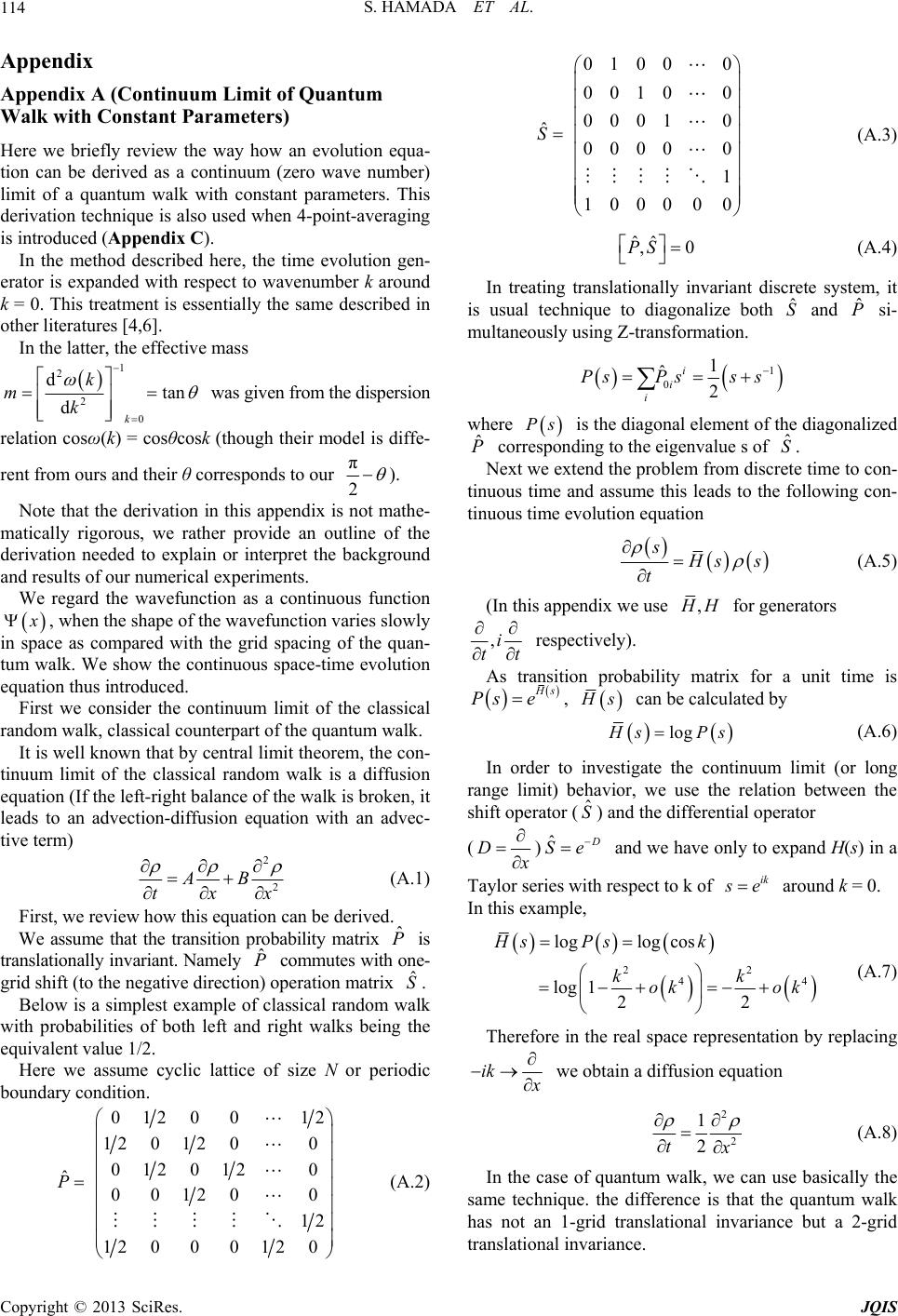 S. HAMADA ET AL. 114 Appendix Appendix A (Continuum Limit of Quantum Walk with Constant Parameters) Here we briefly review the way how an evolution equa- tion can be derived as a continuum (zero wave number) limit of a quantum walk with constant parameters. This derivation technique is also used when 4-point-averaging is introduced (Appendix C). In the method described here, the time evolution gen- erator is expanded with respect to wavenumber k around k = 0. This treatment is essentially the same described in other literatures [4,6]. In the latter, the effective mass 1 2 2 0 dtan dk k mk was given from the dispersion relation cosω(k) = cosθcosk (though their model is diffe- rent from ours and their θ corresponds to our π 2 ). Note that the derivation in this appendix is athnot me- m uous function atically rigorous, we rather provide an outline of the derivation needed to explain or interpret the background and results of our numerical experiments. We regard the wavefunction as a contin in spa , when the shape of the wavefunction varies slowly ce as compared with the grid spacing of the quan- tum walk. We show the continuous space-time evolution equation thus introduced. First we consider the continuum limit of the classical ra tin ndom walk, classical counterpart of the quantum walk. It is well known that by central limit theorem, the con- uum limit of the classical random walk is a diffusion equation (If the left-right balance of the walk is broken, it leads to an advection-diffusion equation with an advec- tive term) 2 2 AB tx (A.1) First, we review how this equation can be derived. We assume that the transition probability matrix ˆ is translationally invariant. Namely ˆ commutes withne- grid shift (to the negative directiooperation matrix ˆ S. Below is a simplest example of classical random wlk o a n) w yclic lattice of size N or periodic bo ith probabilities of both left and right walks being the equivalent value 1/2. Here we assume c undary condition. 012 0 012 120 1200 012012 0 ˆ 00120 0 12 12 00012 0 P (A.2) 0100 0 0010 0 0001 0 0000 0 1 1000 0 0 ˆ S (A.3) 0 ˆ , ˆ PS (A.4) In treating translationally invariant is usual technique to diagonalize discrete system, it both ˆ S and ˆ si- multaneously using Z-transformation. 1 0 ˆ1 2 i i i PsPss s w Ps is the diagonal element of the diagonalized here ˆ corresponding to the eigenvalue s of ˆ S. Next we extend the problem from discrete time to con- tinuous time and assume this leads to the fllowing con- tinuous time evolution equation o s ss t (A.5) (In this appendix we use , H for genrators e ,i tt respectively). As transition probability matrix for a unit time is Hs se, Hs can be calculated by logHsPs e colong range limuse the relation bet shift ope differential operator (A.6) In order to investigate thntinuum limit (or it) behavior, we ween the erator (ˆ S) and th (D )ˆ Se and we have only to expand H(s) in a ik e around k = 0. Taylor series with respect to k of In this example, 22 44 loglog cos log Hs Psk kk ok ok (A.7) 1 Therefore in the real space representation by replacing 22 ik we obtain a diffusion en quatio 2 2 1 2t In the case of quantum walk, we can use basically the sa has translational invariance. (A.8) me technique. the difference is that the quantum walk not an 1-grid translational invariance but a 2-grid Copyright © 2013 SciRes. JQIS  S. HAMADA ET AL. 115 2 ,0, ˆˆ ˆˆ ,0US US (A.9) We 2 × 2-block-diagonalize both and simul- taneously by Z-transformation. This time, unlike the case of classical random walk, w (A.10) a t ndices) of Z-transformation of U is obtained by the matrix multiplication of Z-transformation of each factor. ˆ Uˆ S e use Z-transformation of 2 × 2 matrix unit. 22 0:1,2 :21 22 ˆ ˆ i ii i Us U s 0:1,2 :212 01 0 i ii i Ss Ss s Here 0:1,2 :21 ˆii U denotes 2 × 2 subm trix (0 o 1 row indices and 2i to 2i + 1 column iˆ U. If we use the factorization form 1 ˆˆ ˆˆˆ USESF of Figure 1. 1 2222 201 0 UsSsEsSs Fs sEF 2 20 10 s (A.11) E, F beingNow we assume the 2 × 2 matrix form of B EF CD (A.12) 2 1 2 2 11 0 0 AB s Us CD s Cs Ds As Bs Then we regard the square root ofas 1-walk evolution matrix. (A.13) 2 Us 11 2 CsDs Us Us sBs (A.14) The logarithm of U(s) is obtained by dec into the scalar part and the traceless part as follows. omposing U(s) 22 22 exp arctan (A.15) arccos UsI ii (,, C ,:22 matrix with trace 0 and 2I ) 22 logi log logHsUsI i .16) As has eigenvalues +1 and −1, we can obtain (A Δ , fro 1 trace 2UsCs Bs (A.17) 22 det UsAD BC ii (A.18) Now we cder mA, B, C b H are Pauli’s matri- ces. Then using onsiore concrete form for (, D). expcos sin cos sin sin cos xy i ib i AB ii CD ie e ie ere, (A.19) 01 0 , 10 0 xy i i ik e we have 1tracesin cos 2 ib Us ike (A.20) 22 detiib Us e (A.21) and therefore 22 222 π, 2 arccos sincos0π sin1sincos cos m sin sin Hsbi i k k k (A.22) sin sincos 1 sincossin sin ik ik ke ek (A.23) In order to investigate the continuum ehavior, we expand limit (or long range limit) b in a Taylor series with respect to k of ik e around k = 0 and we have 22 2 23 3 22 2 arccos sincos sin sin arccos sincos 1s 1sin coscos 21sin co in cos s ik kok e k k (A.24) Here we use the Taylor expansion of arccos, 2 3 3 222 arccos ax 1 arccos 2 11 0 arccosπ. xax aox aa Copyright © 2013 SciRes. JQIS 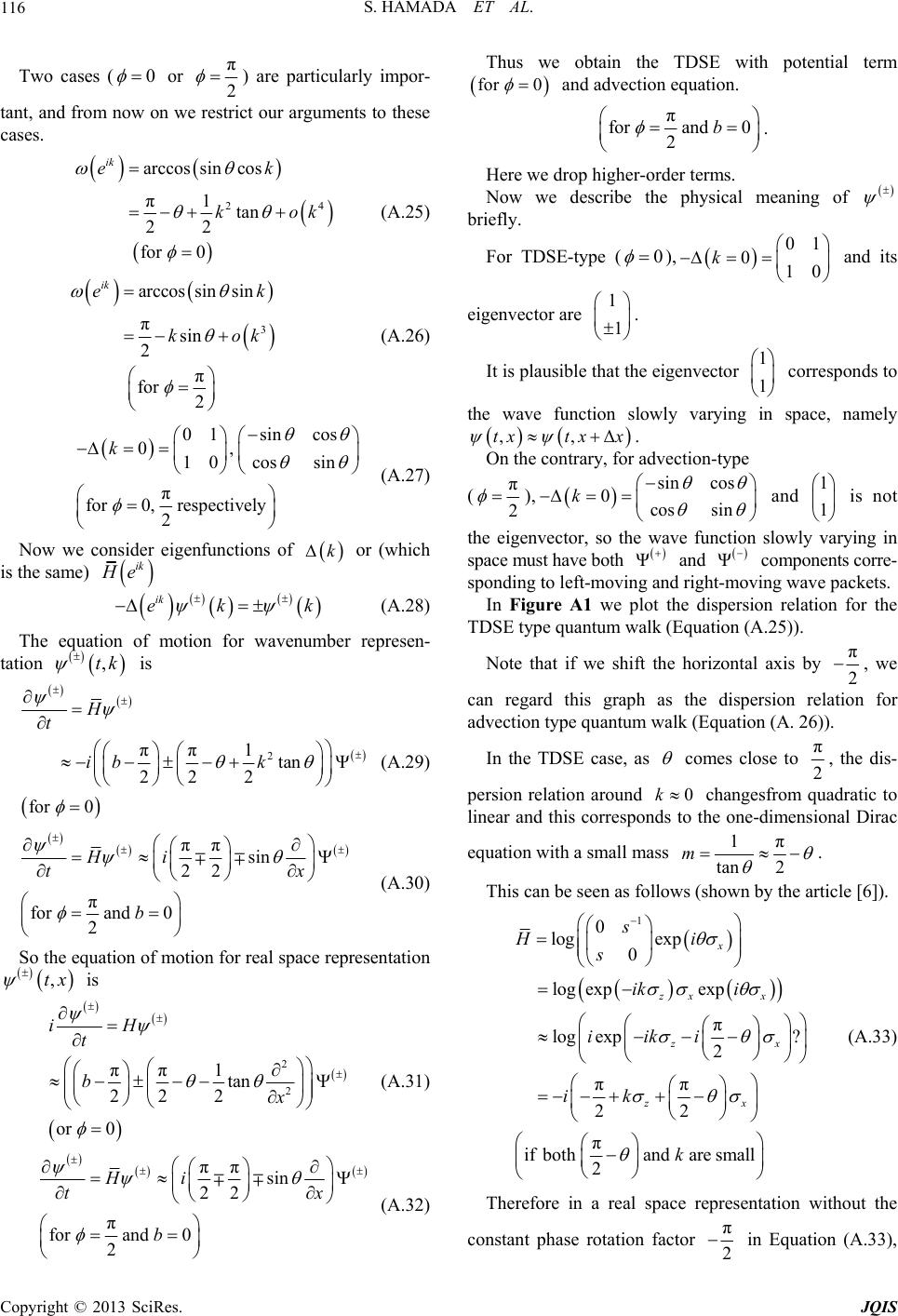 S. HAMADA ET AL. 116 Two cases (0 or π 2 ) are particularly impor- tant, and from now on we restrict our arguments to these cases. 24 arccos sincos π1tan 22 for 0 ik ek ko k (A.25) 3 arccos sinsin πsin 2 π for 2 ik ek kok (A.26) 01sincos 0, 1cossin k0 2 π for0, respectively (A.27) Now we consider eigenfunctions of k or (which is the same) ik e ik ek k The equation of motion for wavenumber represen- tation is (A.28) ,tk 2 ππ 1tan 22 for 2 0 H t ib k (A.29) ππ sin 22 πand 0 2 So the equf m for Hi tx b (A.30) ation ootion for real space representation is ,tx 2 2 ππ 1tan 22 r 2 o0 t bx (A.31) iH ππ sin 22 πand 0 2 for Hi t b x (A.32) Thus we obtain the TDSE with potential term for 0 and advection equation. πandf0 2 or b . Here we drop higher-order terms. cribe the physical meaning of Now we des briefly. For TDSE-type (0 ), 01 010 k and its eigenvector are 1 1 . It is plausible that the eigenvector corresponds to the wave function slowly varying in space, 1 1 namely ,,Δtxtx x . On the contrary, for advection-type (π 2 ), 0cos sin ksincos and 1 is not r, so the wave functio 1 the eigenvecton slowly varying in space must have both Ψ and components corre- sponding to left-md rig wave packets. on relation for the TD that if we shift the horizontal axis by Ψ ght-movinoving an In Figure A1 we plot the dispersi SE type quantum walk (Equation (A.25)). Note π 2 , we caph as the dispersion rela advection type quantum walk (Equation (A. 26)). se, n regard this gration for In the TDSE caascomes close to π 2 , the dis- persion relation around 0k changesfrom quadratic to linear and this corresponds to the one-dimensional Dirac equation with a small mass 1π tan 2 m . This can be seen as follows (shown by the article [6]). 1 0 log exp 0 ππ x z s Hi s i factor log expexp π xx ik log exp? 2 zx ii ki (A.33) 22 zx ik π ifbothandare small 2k Therefore in a real space representation without the constant phase rotation π in Equation (A.33), 2 Copyright © 2013 SciRes. JQIS  S. HAMADA ET AL. 117 Figure A1. dispersion relation for TDSE (or advection) type quantum walk. we have 2 zx ii tx (A.34) Finally we comment about unit system. By comparing the continuum limit evolution equation for the TDSE- type quantum walk with and b 2 2 1tan 2 it H b x (A.35) and the usual TDSE 2 2 ψ1 HψiV 2tmx (A.36) y that the correspondence relation we can sa 1tanand Vb m hold. It is true if we u units system of where means the time in se the 1txt terval of each step and Δ means the grid interval. If we use more general units system, we must say that 2 1tanand tVt b mx using dimensionless quantities. Throughout this article we call 1 2m as imaginary diffusion coefficient. One more important comment to say is that in a finite difference (leap-frog) method 2 Δ, 2Δ ,Δ,Δ2 1 2Δ ttx it tx xtx x mx there is a sharp stability nondimensionalized imag Δ,ttx ,tx (A.37) condition (CFL condition) for inary diffusion coefficient 2 11 2 t mx [1uantum walk there is no such limitation. 3], but in q Appendix B (Factorization of Unitary Hon la. trix can be found in articles such as Banded Matrix) ere we briefly review the factorizatiof 2-grid trans- tionally invariant unitary banded matrix Factorization of ma [14]. We will show 224221 ˆˆˆˆˆˆˆˆˆ ˆˆ ˆˆ SABSCSSDSSES F (B.1) that corresponds to Figure A2, or equivalently. 24 ˆˆ ˆˆˆˆ ˆˆˆˆ BS CSDSESF (B.2) (Note that 2 ˆ S commutes with any matrix dealt here). By the unitarity 24 24 ˆˆ ˆˆ ˆˆˆ ˆˆˆ ˆ BSCSABSCSI (B.3) or equivalently (after Z-transformation) 24 24 ABs ABsCs Cs 2 I 24 4 AA BB CCAB BC BA CBACCAs s ss (B.4) get we can C BC AB C AB C AB B A A C D D D D D =x E E E E x F F F F F EE EE Figure A2. Factorization of unitary banded matrix. Copyright © 2013 SciRes. JQIS 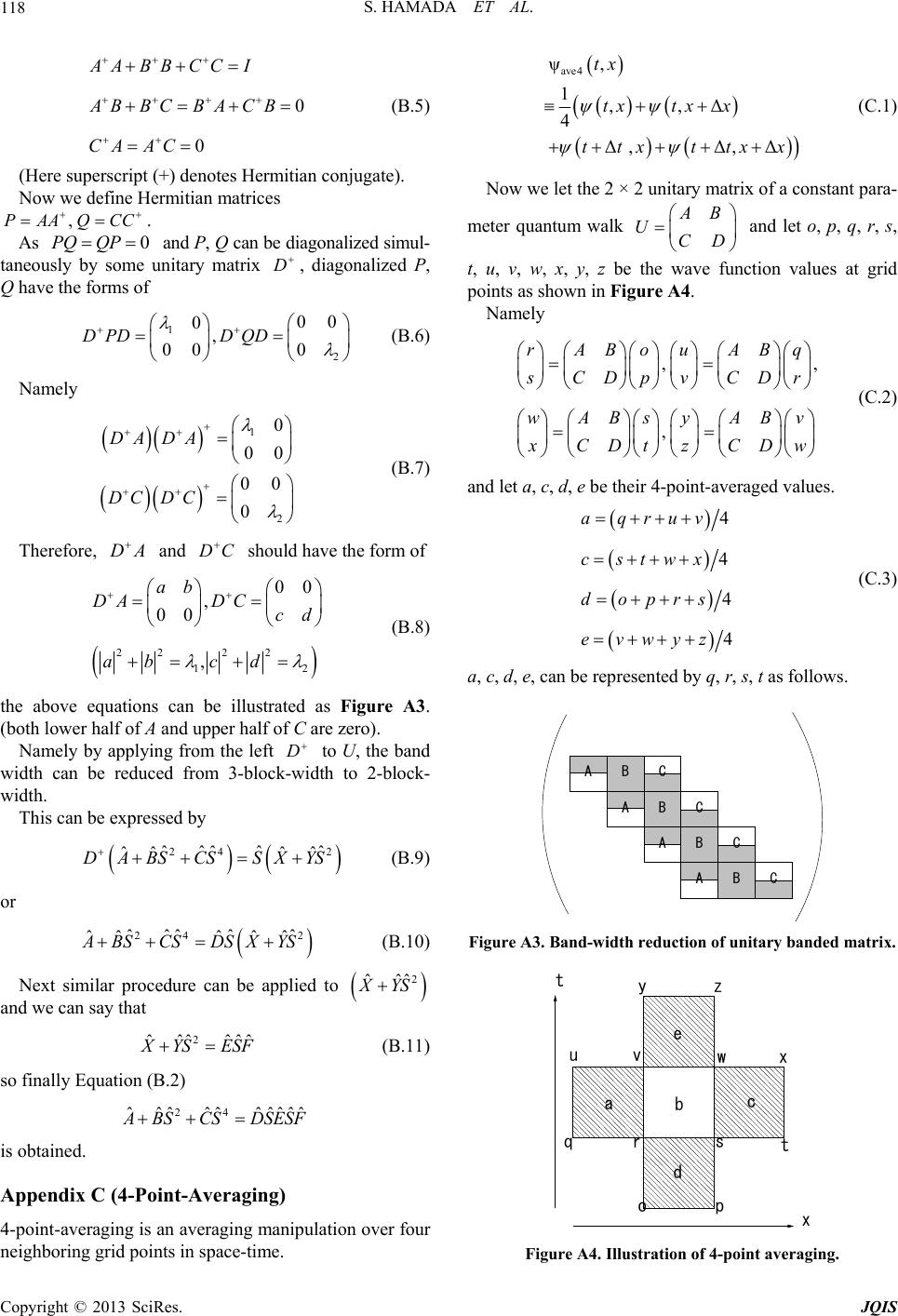 S. HAMADA ET AL. 118 0 0 AA BB CCI ABBCBA CB CA AC erscript (+) denotes Hermitian conjugate). efine Hermitian matrices and P, Q can be diagonalized simul- taneously unitary matrix diagonalized P, Q have the forms of (B.5) (Here sup Now we d ,AQCC . As 0PQ QP PA by someD, 1 2 00 0,0 00 DPDDQD (B.6) Namely 1 2 0 00 00 0 DADA DC DC (B.7) Therefore, A and should have the form of DC 222 2 12 , ab cd 00 , 00 ab DADC cd (B.8) the above equations can Figure A3. (bwer half of k-w This can be expressed by be illustrated as A oth lo and upper half of C are zero). Namely by applying from the left D to U, the band width can be reduced from 3-blocidth to 2-block- width. 24 ˆˆˆˆˆˆ ˆˆ ˆ DABS CSSXYS 2 (B.9) or 24 ˆˆˆˆ ˆˆ ˆˆ ˆˆ2 BSCSDS XYS (B.10) Next similar procedure can be applied to 2 ˆ ˆˆ YS and we can say that 2 ˆˆ ˆˆˆˆ YS (B.11) ESF so finally Equation (B.2) 24 ˆˆˆˆ ˆˆ ˆˆˆˆ BS CSDSESF is obtained. r four ne Appendix C (4-Point-Averaging) 4-point-averaging is an averaging manipulation ove ighboring grid points in space-time. 1,, 4tx t ave4 ψ,tx Δ Δ ,Δ,Δ x x ttx ttxx (C.1) we let the 2 × 2 unitary matrix of a constant para- meter quantum walk Now B UCD and t, es at grid let o, p, q, r, s, u, v, w, x, y, z be the wave function valu points as shown in Figure A4. Namely ,, , rABouABq CDpvCD r wABsyABv CD tzCDw (C.2) ed values. and let a, c, d, e be their 4-point-averag 4arvuq 4 4 4 cstwx doprs evw zy (C.3) a, c, d, e, can be represented by q, r, s, t as follows. A A B B C C A A B B C C Figure A3. Band-width reduction of unitary banded matrix. abc d yz e op qr s t uv wx x t Figure A4. Illustration of 4-point averaging. Copyright © 2013 SciRes. JQIS 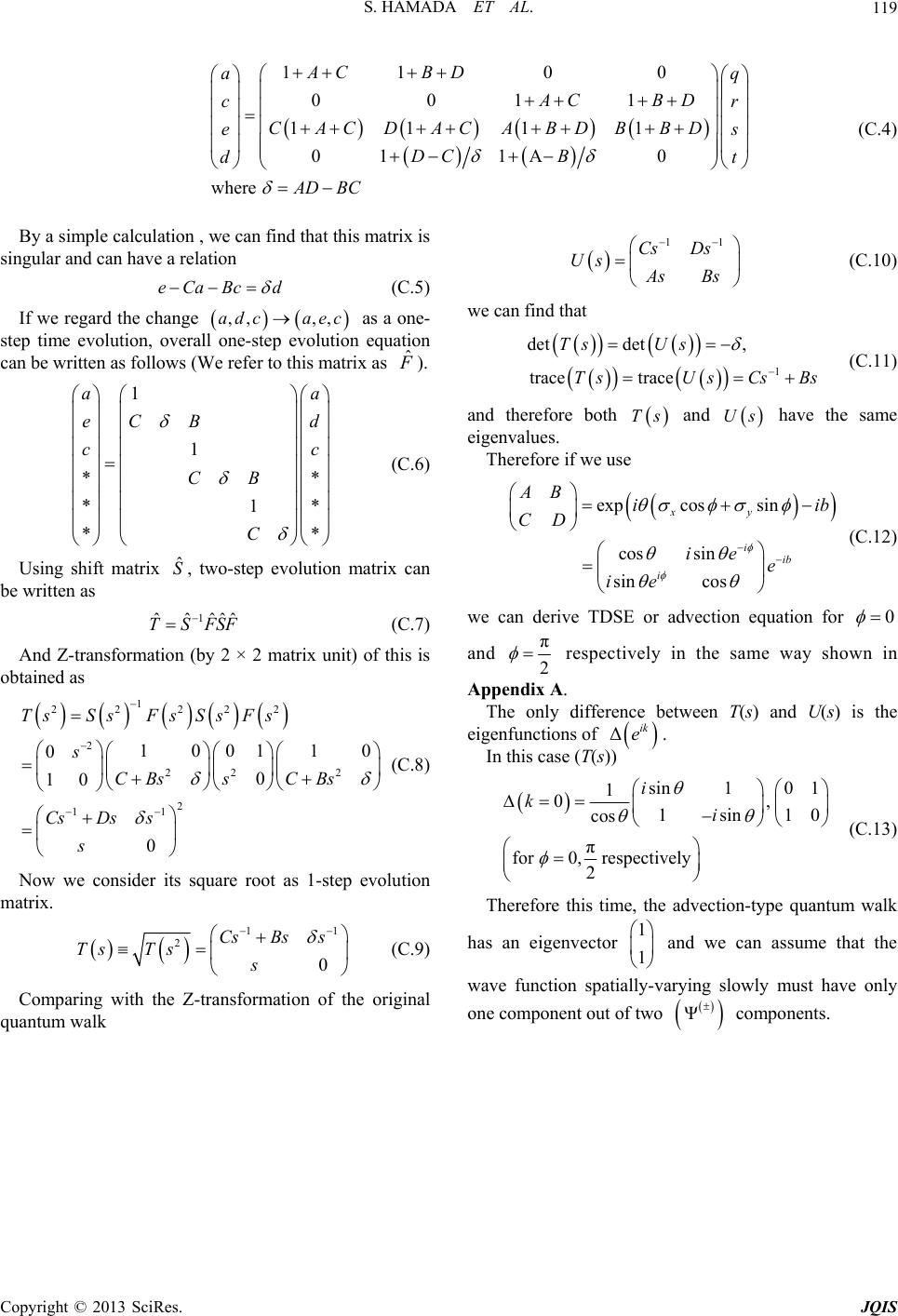 S. HAMADA ET AL. Copyright © 2013 SciRes. JQIS 119 11 00 0011 1111 01 1A0 where AC BD aq AC BD cr CACDACABDBBD es DC B dt AD BC (C.4) By a simple calculation , we can find that this matrix is singular and can have a relation 11 Cs Ds Us sBs (C.10) we can find that eCaBcd (C.5) If we regard the change ,, ,,adcaec rall one-step evolution e (We refer to this ma as a one- step time evolution, ovequation can be written as follows trix as ˆ ). * (C.6) ep evolution matrix can be written as s 1 1 ** *1 aa eC Bd cc CB 1 det det, tracetrace TsUs TsUsCs Bs (C.11) and therefore both Ts and Us have the same **C Using shift matrix ˆ S, two-st eigenvalues. Therefore if we use b (C.12) w expcossin cos sin sin cos xy i ib i AB ii CD ie e ie e can derive TDSE or advection equation for 0 1 ˆ ˆ TSFSF (C.7) And Z-transformation (by 2 × 2 matrix unit) of thi is obtained as ˆ ˆˆ 1 22222 2 22 2 11 100110 0 0 10 0 TsSsFs Ss Fs s CBss CBs CsDs s s 2 (C.8) Now we consider its square root as 1-step evolution matrix. 11 Bs s 2 0 Ts Tss (C.9) Cs Comparing with the Z-transformation of the original quantum walk and π 2 respectively in the same way shown in Appendix A. The only difference between T(s) and U(s) is the eigenfunctions of Δik e. s)) In this case (T( sin101 1 0, 1sin10 cos 0, respectively i ki Therefore this time, the advection-type quantum walk has an eigenvector and we can assume that the wave function spatially-varying slowly must have only one component out of two forπ (C.13) 2 1 1 Ψ components.
|